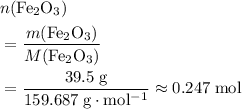
Chemistry, 07.06.2021 14:00 nataliahenderso
The reaction of iron (III) oxide with carbon monoxide produces iron and carbon dioxide.
Fe, O3(s) + 3CO(g) - 2Fe(s) + 3C0 (9)
If you have 39.5g of Fe2O3, how many grams of CO are required for a complete reaction?

Answers: 2
Another question on Chemistry

Chemistry, 21.06.2019 19:00
The skeletal system performs a variety of functions that are crucial to maintaining life processes. what function is performed in the bone marrow, but not in the ossified bones of the skeleton? a oxygen transportation c mineral storage b. muscle attachment d red blood cell production
Answers: 3

Chemistry, 22.06.2019 06:00
Compare and contrast physical changes with chemical changes.
Answers: 3

Chemistry, 22.06.2019 10:30
Use this information to determine the number of calends electrons in the atoms. which of the following correctly compares the stability of the two atoms? a) both are unreactive b) both are highly reactive c) a is unreactive and d is reactive d) a is reactive and d is unreactive
Answers: 2

Chemistry, 22.06.2019 15:10
The ozone molecule o3 has a permanent dipole moment of 1.8×10−30 cm. although the molecule is very slightly bent-which is why it has a dipole moment-it can be modeled as a uniform rod of length 2.5×10−10 m with the dipole moment perpendicular to the axis of the rod. suppose an ozone molecule is in a 8000 n/c uniform electric field. in equilibrium, the dipole moment is aligned with the electric field. but if the molecule is rotated by a small angle and released, it will oscillate back and forth in simple harmonic motion.what is the frequency f of oscillation?
Answers: 2
You know the right answer?
The reaction of iron (III) oxide with carbon monoxide produces iron and carbon dioxide.
Fe, O3(s) +...
Questions

Biology, 21.07.2019 13:30


Arts, 21.07.2019 13:30

Computers and Technology, 21.07.2019 13:30


Mathematics, 21.07.2019 13:30


Chemistry, 21.07.2019 13:30




History, 21.07.2019 13:30


Social Studies, 21.07.2019 13:30


History, 21.07.2019 13:30

History, 21.07.2019 13:30



 .
.  .
. :
:  .
. :
:  .
. :
:  .
. .
. .
. formula units in
formula units in  of this compound:
of this compound: .
. .Coefficient of
.Coefficient of  :
:  .
. of
of  .
.![\begin{aligned}&n({\rm CO}) \\ &= n({\rm Fe_2O_3}) \cdot \frac{n({\rm CO})}{n({\rm Fe_2O_3})} \\[0.5em] &\approx 0.247\; \rm mol \times 3 \approx 0.742\; \rm mol\end{aligned}](/tpl/images/1365/1629/cad85.png) .
. to find the mass of that
to find the mass of that  of
of  .
.

